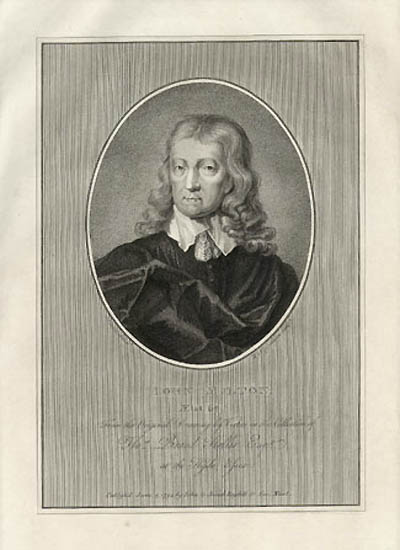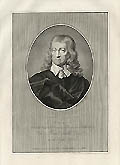| Title: |
John Milton, Age 62 |
| Engraver: |
Gardiner, William Nelson (Dublin, 1766 - London, 1814) |
| Designer: |
Vertue, George (St. Martin's in the Fields, 1684 - London, 1756) |
| Date: |
1794 |
| Medium: |
Original Stipple Engraving and Etching |
| Publisher |
John and Josiah Boydell & George Nicol, London |
| Source: |
The Poetical Works of John Milton |
| Note: |
William Nelson Gardiner: An Irish engraver, William Nelson Gardiner studied
art techniques at the Dublin Academy. Around 1790 he came to London and
became a principal assistant to Francesco Bartolozzi. Working under Bartolozzi,
Gardiner engraved plates for Harding's Shakespeare, De Grammont's Memoirs and Diana Beauclerk's illustrations to Dryden's Fables. William Nelson Gardiner also engraved
important plates after Bunbury, Hamilton and Francis Wheatley. His portraits,
in particular, were highly sought after by major publishers such as Boydell. |
| |
Despite his obvious talents as an engraver, it is reported that William Gardiner
led a restless life. Near the year 1800 he returned to Dublin and is said
to have squandered all his money. He then studied at Cambridge with the
view of taking orders. When these studies proved unsuccessful William Nelson Gardiner
became a bookseller in London. Finally, in 1814, this once fine engraver
took his life by suicide. |
| |
George Vertue: Vertue's fine line and mezzotint engravings
of architectural views and portraits cover only a portion of his high
position in the history of British art. As early as 1713 he began his
antiquary researches which would later be published under the title of, History of the Arts in England. This, along with his other valuable
researches and writings formed the basis in the latter eighteenth century
for Horace Walpole's, Anecdotes of Painting in England. |
| |
Born in humble circumstances, George Vertue was apprenticed
to the engraver, Michiel Van Der Gucht, for a period of seven years. He
began working for himself in 1709 and also devoted himself to studying
French, Dutch, Italian and music. In 1711 Vertue became a founding member
of the Academy of Painting in which Sir Godfrey Kneller was at its head.
Working closely engraving the designs of Kneller, George Vertue came to the attention
of the Society of Antiquaries and, in 1717, he was appointed its First
Draughtsman and Engraver. Much of Vertue's engraved work from this point
on was commissioned by the Society |
| |
George Vertue's portrait engravings are also well known for his
contributions to the historical series, Heads of the Illustrious Persons
of Great Britain, published in London in parts between 1734 and 1752.
George Vertue engraved approximately half of the plates, while the others
were engraved by the Dutchman, Jacobus Houbraken (1698-1780). William Nelson Gardiner's original etching entitled, John Milton, Age 62 is based upon a design created by George Vertue. |
| |
A Biographical Note: John Boydell is easily one of England's most remarkable 18th century
personalities. Born in poverty, he began his career as an at best mediocre
engraver of small book plates. At this time England was at a very low ebb
as a serious centre for the visual arts (particularly engraving) and Boydell
sought to eradicate this situation by beginning a second career as a publisher
of fine prints. Modest initial experiments in the 1760's led to a rapid
expansion of his business and during the 1770's he published his striking
series of mezzotint engravings, Liber Veritas, engraved by Richard Earlom
after the drawings of Claude Lorrain. This ambitious undertaking put England
back on the printmaking map and was a huge financial success for John Boydell. |
| |
Boydell had now established London as a major centre for the arts and
this once poor and struggling engraver/publisher was acknowledged for his
efforts by being elected no less than Lord Mayor of London, in 1791. The
same year marked the beginning of Boydell's most grandiose undertaking.
His new publishing establishment in Pall Mall, 'the Shakespeare Gallery',
began by commissioning the most esteemed painters and engravers in the
country to create and design large and expensive engravings based upon
the plays and life of William Shakespeare. By this time as well John Boydell's nephew, Josiah Boydell (1752-1817), had joined the firm. |
| |
This monumental venture continued until Boydell's death thirteen years
later. By that time, The Shakespeare Gallery had created and published
one hundred and seventy engravings on a grand scale. Alas, the expenses for this vast project had been so large that England's foremost publisher of art ended his life the way he began, dying penniless. Note: During that period, William Shakespeare's name was also spelt, 'Shakspeare', thus the spelling for Boydell's (Shakespeare Gallery) appears printed as 'Shakspeare Gallery'. |
| |
At this time England's other great literary giant, John
Milton, was honoured
by Boydell. The Poetical Works of John Milton was published in three parts
in 1794, 1795 and 1797. Sparing no expense, Boydell commissioned George
Romney to design a portrait plate and Richard Westall to design images
illustrating each part of Paradise Lost and Paradise Regained as well as
the more famous individual poems. The engravers included Richard Earlom,
Thomas Kirk, J. P. Simon, Benjamin Smith, Moses Haughton, William Nelson Gardiner,
Dutterau and John Ogborne. This original etching was created by William Nelson Gardiner and published by John and Josiah Boydell & George Nicol, London in 1794 for The Poetical works of John Milton. This impression is lettered with the title, "John MIlton, Aetat 62", and includes the production detail, " Virtue delint. W. N. Gardiner Sculpt. From the Original Drawing by Vertue in the Collection of Thos. Brand Hollis Esq. at the Hyde Essex. Published June 4 1794 by John and Josiah Boydell & Geo. Nicol" below the image. |
| |
Unlike the Shakespeare engravings, the Milton prints were constructed
almost solely in the stipple technique. Stippling reached its golden age
in late eighteenth century England. The technique was promoted and taught
by Francesco Bartolozzi (Florence, Italy, 1727 - Lisbon, Portugal, 1815). Many of the above mentioned engravers
were among his finest students. Briefly, stippling was a tonal method where
the image was created not with solid lines but with a multitude of dots
or flicks. Under a master's hand, stippling magnificently captured tonal
values by contrasting areas of light and shade. Unfortunately it was most
laborious and quickly became extinct with advances in aquatint engraving
in the early nineteenth century. Yet to this day some of the most subtle
and sensual engravings in the history of British art belong to the stipple
engravers of the late eighteenth century. |
| |
John Milton (British, 1608 - 1674): John Milton is considered one of England's most significant poets. He created such masterworks as "Paradise Lost", "Samson Agonistes" and "Comus". Milton was first admitted to St. Paul's School and at the age of fifteen, he entered Christ's College with the intention of becoming a priest in the Church of England, a vocation he later rejected. According to the Poetical works of John Milton edited by David Masson, M.A. LL.D., Professor of Rhetoric and English literature in the University of Edinburgh, Volume 1, published by Macmillan and Co., New York 1890, Milton wrote various poems in 1626, such as Elegia Prima, Elegia Tertia, Elegia Secunda, and continued this set with Elegia Quarta (1627), Elegia Quinta (1627), Elegia Septima (1828) , and others. in 1626, two years before receiving his bachelor of arts and master of arts degrees, Milton wrote his first major English poem, On the Death of a Fair Infant, Dying of the Cough. The poem relates to the death of his infant sister's death. On the Morning of Christ's Nativity, was written in 1629. John Milton left Cambridge University in 1632 and that same year, he composed the finest and most classic of his minor English poems. L'Allegro, Il Penseroso, followed by Arcades (1633), Comus (1634), first published under the title, A Masque, Presented at Ludlow Castle, and Lycidas in (1637) written after the death of his former fellow collegian at Cambridge, Edward King. By 1952, Milton was totally blind. Inspired by the biblical story of the Creation, the fall of Adam and Eve, the rebellion of Satan against God and Satan cast out of heaven, John Milton had his great epic, Paradise Lost published in 1667, a masterpiece which tells of the fall of Satan and the rebel angels, and that of Adam and Eve, etc. In 1671, a continuation to Milton's last great work, a shorter epic and supplement to Paradise Lost, Paradise Regained, which tells of Satan's temptation of Christ in the desert and the rejection by Jesus of Satan's temptation. John Milton wrote a few more works before his death, they include, Samson Agonistes which is believed to go back to the 1640's or may be one of his last works, Art of Logic (1672), Of True Religion (1673), and the year he died, 1674, he wrote Epistolae Familiares. |
| Size: |
10 1/2 X 7 (Sizes in inches are approximate, height
preceding width of plate-mark or image.) |
| |
Matted with 100% Archival Materials |
| Buy Now |
Price: $295.00 US |
| Condition: |
Printed upon late eighteenth century wove paper and with full margins as published by Boydell in London in 1794. This impression is lettered with the title, "John MIlton, Aetat 62", and includes the production detail, " Virtue delint. W. N. Gardiner Sculpt. From the Original Drawing by Vertue in the Collection of Thos. Brand Hollis Esq. at the Hyde Essex. Published June 4 1794 by John and Josiah Boydell & Geo. Nicol" below the image. Containing slight scuffing and
spotting in the outer margins else a fine, early impression and in very good condition throughout. This original etching and stipple engraving represents a prime, original example of the eighteenth century portrait art of William Nelson Gardiner. |
| Important Information: |
The artist biographies, research and or information pertaining to all the original works of art posted on our pages has been written and designed by Greg & Connie Peters exclusively for our site, (www.artoftheprint.com). Please visit us regularly to view the latest artworks offered for sale. We will soon be posting an update of our most recent research and include the biographical and historical information pertaining to our next collection of original works of art created by artists throughout the centuries. We hope you found the information you were looking for and that it has been beneficial.
Our Gallery, (Art of the Print / www.artoftheprint.com) guarantees the authenticity of every work of art we sell 100%. Full documentation and certification is provided. We offer a wide selection of international fine art dating from the early Renaissance to the contemporary art period. |



























![]()
![]() or
phone Greg & Connie (905) 957-6666
or
phone Greg & Connie (905) 957-6666